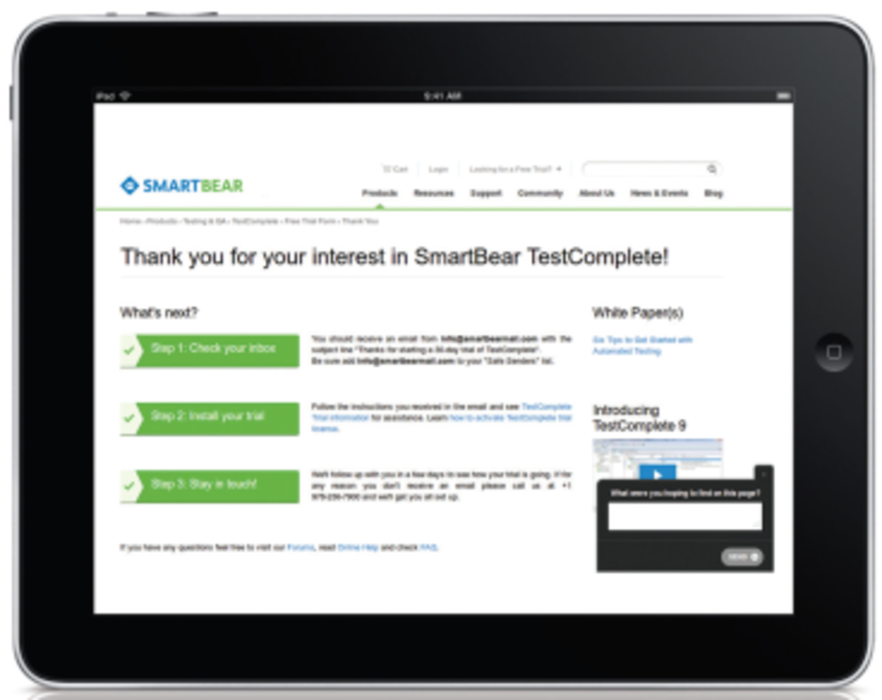Client: SmartBear Software
Solution: Marketo Inc.
Objective: Implement a unified, flexible backend system in order to granularly track leads and double revenue within three years
The Back Story: Growth is a good thing—but only if your backend tools can flexibly expand with you as you develop.
That was the situation facing SmartBear, a software company that creates and distributes quality assurance tools for developers, engineers, and IT professionals. After its rapid-fire acquisitions of API monitoring company AlertSite in April 2011 and, just three months later, of Eviware—creator of popular test-ware app soapUI—SmartBear was poised for a major surge in leads and revenue.
The only problem was—and it’s a good problem to have—scaling to meet the increase in both areas.
Following the acquisitions, SmartBear was also faced with the task of integrating marketing and lead management systems for the three business units—each with their own sales teams, internal processes, homegrown CRM systems, and various email marketing campaign tools—into a single system that could easily track and target a multitude of different free trial downloads. SmartBear operates on a freeware business model—a free trial download followed, hopefully, by the paid version.
“We wanted common automaton capabilities, but we also wanted each different product group to be able to maintain its autonomy,” says KC Lincoln, SmartBear’s VP of marketing.
In addition to all that, SmartBear was looking for more robust reporting capabilities. Its CRM system at the time only provided SmartBear with what Lincoln calls “a snapshot in time.” Even if a prospect had downloaded information on a long list of products—SmartBear has 15 distinct offerings—its homegrown CRM solution was only capable of showing information about the most recent product. While SmartBear could create custom objects in the back end to better track its customers, the process was messy and complicated.
SmartBear also needed to be able to get “surgical” with its segmentation, says Gary DeAsi, marketing manager at SmartBear.
“We had to figure out how to split our different audiences in terms of products and messaging, because there are some cases in which segments of audiences overlap,” DeAsi says. “What we had was one massive group of leads that we needed to carve out into various lists and segments of lists to market all our different products.”
The Solution: It was a tall order. SmartBear did prodigious research on all the big players in the space before finally choosing marketing automation service provider Marketo.
After Marketo was integrated into SmartBear’s content management system, Salesforce.com, and other internal SmartBear systems, including multiple license servers and lead management tools, the “Marketo Ninjas”—as SmartBear’s marketing team cheekily began to refer to itself—started to get down and dirty with the company’s data.
For every product, SmartBear can now track a variety of channels, including email, paid media, social media, and Web throughout all of its inbound and outbound initiatives.
Most of SmartBear’s organic inbound leads, about 80% these days, come from free downloads of its software spurred on by online content marketing efforts—e-books, webinars, and the like. “But that doesn’t get us the revenue growth we need—the hardest part is the remaining 20%,” Lincoln says.
That’s where outbound comes in. Now that it has the resources, SmartBear has upped its lead nurturing efforts to finesse leads down the funnel with drip campaigns set up in Marketo using relevant content as a catalyst. “If a lead is related to a certain character or persona in the system, we provide the right content to drive that lead to a trial,” DeAsi says.
The audience for the company’s products is a complex matrix of overlapping segments, but now DeAsi and his team are able to tackle granular segmentation for targeting that makes sense without over-touching prospects. The company is now sending out between 15 and 20 different outbound campaigns in a single morning without a problem.
“We can use all that data we collect in the smartest way possible to create segments when we have big email days, and we’re using intelligence and flexibility to create segments on a regular basis,” DeAsi says. “We do that for so many different campaigns at the same time and there’s no overlap—that’s been huge for us.”
The Results: SmartBear was able to meet its goals and then some. In addition to tripling lead volume—the company process more than 30,000 organic inbound trials a month—SmartBear grew its annual revenue by nearly fourfold in two years.
SmartBear also took home the Marketo’s Revenue Performance Excellence Award—known colloquially as a Revvie—this year in the “Most Dramatic Impact—Small and Midsize Business” category.
The Takeaway: Big Data isn’t useful data unless it’s smart data—and without a strong reporting function, forget about it, DeAsi says.
“We have a clean way to track all the different metrics we need,” he adds. “It gives us the flexibility to create reports that give us intelligence to make much better decisions as a marketing team in allocating our time and resources to programs.”








